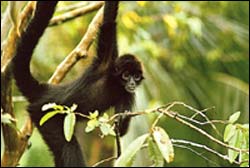Biologist in bid to save rainforest’s rare monkey

Critically endangered: The Brown-headed Spider Monkey
Scientists at the University of Sussex are working with local communities in Ecuador to help save one of the world’s rarest species of monkey – and the endangered rainforest where it lives.
The Brown-headed Spider Monkey (Ateles fusciceps) is “critically endangered”, which means that without urgent action to protect the 50 known breeding pairs still in the wild, the species could become extinct. The spider monkey – unusual in that it is exclusively a fruit-eater – is under threat because up to 80 per cent of the dense rainforest that it depends on for food has been destroyed.
Environmental organisation Ecuador Terra Incognita, supported by partners including the University of Sussex, has now launched the PRIMENET Project to tackle the crisis. Its aim is to determine how best to protect the monkey populations, now restricted to rainforest reserves in northwest Ecuador, then educate local communities to continue the work and ensure the spider monkey’s long-term survival.
University of Sussex environmental biologist Dr Mika Peck is coordinating the project. He has secured £230,000 funding for the project over three years through the Government-sponsored Darwin Initiative to aid conservation in bio-diverse regions around the world. He will also assist, along with colleagues from the geography department, in remote sensing research. This involves analysing satellite data to see where rainforest is at risk from development or logging.
Dr Peck became involved because he has worked on environmental projects in South America and has conducted research into deforestation. He also has a passion for the region where the project will be based – the Los Cedros Biological Reserve in the Ecuadorean Andes, on the doorstep of the spider monkey habitat. He says: “This is one of the most beautiful places in the world. It can only be reached by donkey, trekking for five hours. It is a fairytale setting – orchids, humming birds, big cats, tapirs, moths the size of dinner plates – and is one of the richest areas for bird species.”
Protecting all of this, says Dr Peck, is key to the spider monkey campaign: “The spider monkey is a ‘flagship’ species – if they are protected then everything else in the surrounding environment is too, and one of the rare biodiversity-rich habitats of the world is preserved.”
The project will involve the building of a scientific research and education centre at Los Cedros, where locals from a number of diverse indigenous groups will learn how to collect scientific data and monitor monkey populations. Other strands of the project will focus on supporting Conservation International in developing “corridors” to link nature reserves in the region. Teams of scientists will also study the area’s flora and fauna, much of it still new to science.
In the longer term, the project aims to encourage environmentally-friendly ecotourism, offer sustainable forms of work and income for local people and offset the damage done by logging, mining and hunting – the pursuits largely responsible for destroying the rainforest on which the spider monkey and other species depend.
Media Contact
More Information:
http://www.sussex.ac.ukAll latest news from the category: Ecology, The Environment and Conservation
This complex theme deals primarily with interactions between organisms and the environmental factors that impact them, but to a greater extent between individual inanimate environmental factors.
innovations-report offers informative reports and articles on topics such as climate protection, landscape conservation, ecological systems, wildlife and nature parks and ecosystem efficiency and balance.
Newest articles

Superradiant atoms could push the boundaries of how precisely time can be measured
Superradiant atoms can help us measure time more precisely than ever. In a new study, researchers from the University of Copenhagen present a new method for measuring the time interval,…

Ion thermoelectric conversion devices for near room temperature
The electrode sheet of the thermoelectric device consists of ionic hydrogel, which is sandwiched between the electrodes to form, and the Prussian blue on the electrode undergoes a redox reaction…

Zap Energy achieves 37-million-degree temperatures in a compact device
New publication reports record electron temperatures for a small-scale, sheared-flow-stabilized Z-pinch fusion device. In the nine decades since humans first produced fusion reactions, only a few fusion technologies have demonstrated…





















